Labor, or the lack of it, is a hot topic in the industry, and this, among other things, is pushing automation in the fields, glasshouses, and orchards, as well as in packhouses and down to the end consumers. This does raise the question of how far are advanced are we with robots taking up manual jobs?
At last week’s FPC Future event, there were seminars focussing on all sides of future technology, one of which was on robotics and automation pre-farmgate.
John Giles from Promar chaired the session. He opened by saying there was a need to improve productivity in the sector, that agri-tech cannot answer all of the challenges that we face as an industry, but that we would be hearing much more about it in the future.
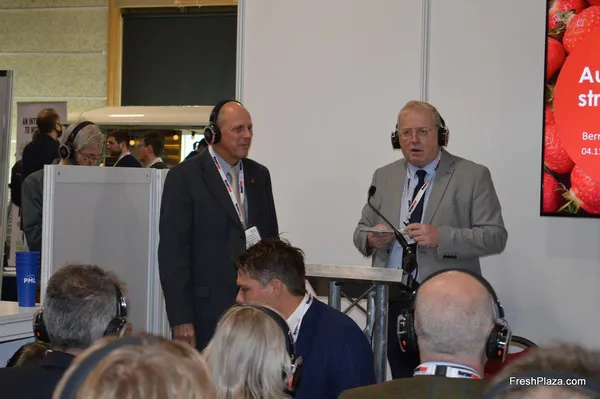
Richard Harnden (right) with John Giles (left)
Richard Harnden from Berry Gardens outlined how, seven years ago, they decided to embrace automation at the company, as they already saw that labor was and would become more of an issue. Berry Gardens worked closely with Lincoln University and embarked on a world tour to investigate what was happing in automation, focusing on innovation in the soft fruit sector.
Berry Gardens worked with Sago Robotics to develop projects on fruit harvesting and crop prediction for strawberries. According to Richard, pickers spend 10-20% of their time walking with trays from the picking areas to the pickup points, costing £120,000 in labor per year.
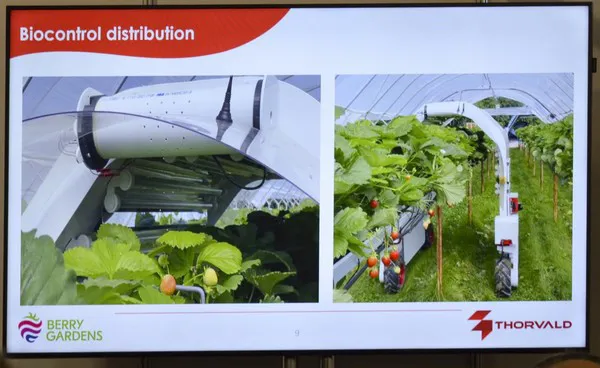
Image from Richard's presentation
Although the autonomous robot Thorvald is not quite at the stage where it can pick fruit, Berry Gardens have robots in place at two of their farms in Kent, where they work through the night applying UV-C treatment to 14 hectares of fruit. They are also being used for early disease detection and distribution of bio-control, which can cost between £35,000 - £50,000 in labor costs per year. The robot can also carry out tasks such as runner removal and grass control, as well as crop prediction.
The big win, according to Richard, will be when the robot can harvest the fruit; he is confident this will be possible in the next few years.
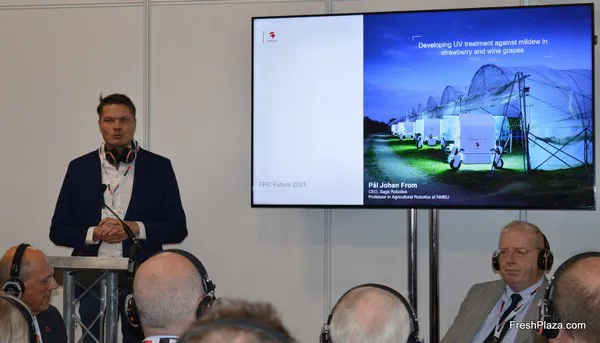
Pål Johan From
Pål Johan From from Saga Robotics, which over the last five years has developed Thorvald, a robot that can operate in an agricultural environment with the robustness and reliability needed for commercial operation. The team is working on a wide range of tools to be developed for Thorvald, but presently, the focus is on developing UV treatment against mildew in strawberry and wine grapes. The robot is currently in operation on commercial farms in Norway, the UK, Italy, and the US, delivering protection against powdery mildew, thus allowing growers to produce strawberries without the use of chemicals and fungicides for mildew protection.
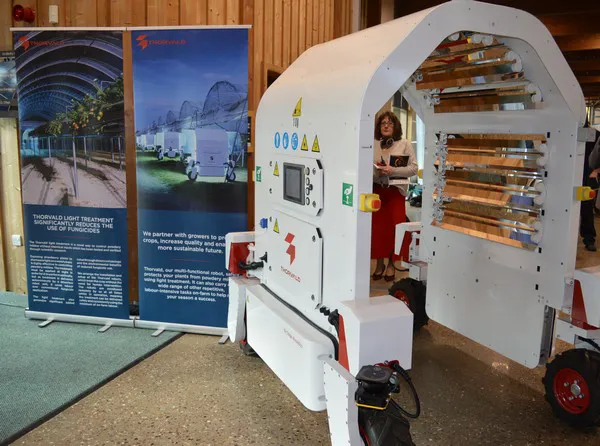
Autonomous robot Thorvald on display at the event
Pål John said that, in the food industry, people are faced with repetitive tasks which can be done by robots. There are 10 robots at work at fruit producer Clockhouse in the UK, which work through the night administering UV treatment against powdery mildew. Currently, they cover 10 hectares, but next year this will increase to 30 hectares. This is the first time it has been done on an industrial scale. The distance driven by the robots is 8000km, which equals the distance between the UK and New York. As the robots work, data is gathered to develop AI to make them safer.
Pål Johan is certain that we will see fleets of robots working in the fields in the future, and that they will play an important part in farming going forward.
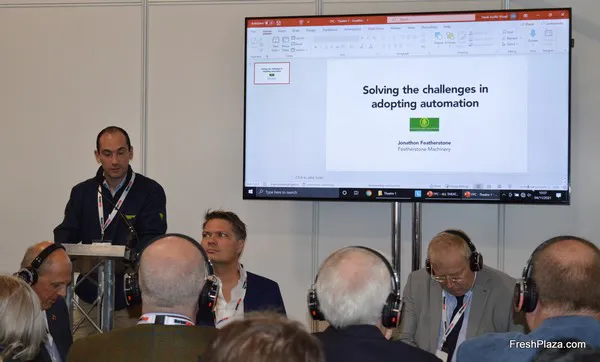
Johnathon Featherstone
Johnathon Featherstone from Featherstone Machinery started by issuing the warning that, if no action is taken, UK production will stop. Vegetable growers face less availability and increasing costs for labor, and thus they are now adopting robotics, but change is difficult.
The harvesting of some vegetables mechanically - brassicas for example - can be challenging, and machinery is expensive; they need to have a good output to be commercially viable. "There have to be more sources of funding and financial incentives to help growers," he said. He gave Covid as an example of how we cannot rely on imported produce. Johnathon also said that consumer mindset had to change: they expect a certain size or shape of vegetable, which makes robotic harvesting more challenging.
There is a need for more companies willing to supply and adapt machines for different products. He called for collaboration between seed companies, growers, and manufacturers to produce new varieties which are more suitable for mechanical harvesting.
